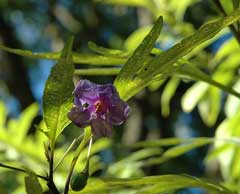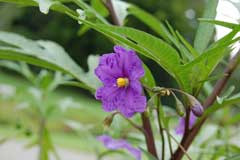 |
|
http://commons.wikimedia.org/wiki/User:Carstor |
 |
| http://commons.wikimedia.org/wiki/User:Rl |
Translate this page:
Summary
Physical Characteristics

 Solanum laciniatum is an evergreen Shrub growing to 3 m (9ft 10in).
Solanum laciniatum is an evergreen Shrub growing to 3 m (9ft 10in).
See above for USDA hardiness. It is hardy to UK zone 9 and is frost tender. It is in leaf all year, in flower from August to October. The species is hermaphrodite (has both male and female organs) and is pollinated by Insects.
Suitable for: light (sandy), medium (loamy) and heavy (clay) soils and prefers well-drained soil. Suitable pH: mildly acid, neutral and basic (mildly alkaline) soils. It cannot grow in the shade. It prefers moist soil.
UK Hardiness Map
US Hardiness Map
Synonyms
Solanum aviculare var. laciniatum
Plant Habitats
Hedge; East Wall. By. South Wall. By. West Wall. By.
Edible Uses
Edible Parts: Fruit
Edible Uses:
Fruit - raw or cooked[105, 173]. It must be thoroughly ripe because the unripe fruit is poisonous[2, 46, 153, 154]. It can be used as a sweet fruit or as a vegetable[61]. Best harvested once it has fallen from the plant, the fruit will then have lost its unpleasant acidity[183]. It tastes much worse than it looks, the fruit is sickly sweet and often bitter[193]. The quality varies from plant to plant and even from year to year from the same plant[193]. The fruit is up to 2cm long and contains a large number of flat seeds[193].
References More on Edible Uses
Medicinal Uses
Plants For A Future can not take any responsibility for any adverse effects from the use of plants. Always seek advice from a professional before using a plant medicinally.
Miscellany
A source of steroids, much used in the pharmaceutical industry. The unripe berries are the richest source[153, 173].
References More on Medicinal Uses
The Bookshop: Edible Plant Books
Our Latest books on Perennial Plants For Food Forests and Permaculture Gardens in paperback or digital formats.

Edible Tropical Plants
Food Forest Plants for Hotter Conditions: 250+ Plants For Tropical Food Forests & Permaculture Gardens.
More

Edible Temperate Plants
Plants for Your Food Forest: 500 Plants for Temperate Food Forests & Permaculture Gardens.
More

More Books
PFAF have eight books available in paperback and digital formats. Browse the shop for more information.
Shop Now
Other Uses
References More on Other Uses
Cultivation details
Succeeds in most fertile soils in a sunny position[182]. Tolerates temperatures down to at least -7°c in Australian gardens[157] but is not very hardy in Britain. It sometimes succeeds as a shrub outdoors in the mildest areas of the country[166] but is more usually cut to the ground by winter cold. It can, however, be grown at the foot of a warm sunny wall and be treated as a herbaceous perennial. As long as the roots are given a good mulch in autumn they should survive quite cold winters[1, 166]. Alternatively, it is possible to grow the plant as an annual. If the seed is sown in early spring in a warm greenhouse and planted out after the last frosts it can fruit in its first year though yields will be lower than from plants grown as perennials[K]. There is much confusion between this species and S. aviculare. Some botanists unite the two under S. aviculare whilst others say that S. laciniatum is a tetraploid form of that species[50]. S. laciniatum is treated as a distinct species here[K].
References Carbon Farming Information and Carbon Sequestration Information
Temperature Converter
Type a value in the Celsius field to convert the value to Fahrenheit:
Fahrenheit:
The PFAF Bookshop
Plants For A Future have a number of books available in paperback and digital form. Book titles include Edible Plants, Edible Perennials, Edible Trees,Edible Shrubs, Woodland Gardening, and Temperate Food Forest Plants. Our new book is Food Forest Plants For Hotter Conditions (Tropical and Sub-Tropical).
Shop Now
Plant Propagation
Seed - sow spring in a warm greenhouse. Germinates in 2 - 3 weeks at 20°c. Prick out the seedlings into individual pots when they are large enough to handle. If growing the plants as annuals, plant them out after the last expected frosts and give them some protection such as a cloche until they are growing well. If growing as a perennial, especially in areas at the limits of its cold-hardiness, it will probably be better to grow the plants on in the greenhouse for their first winter. Give them fairly large pots (12cm or larger) because they have very strong root growth. Top growth might die back over winter, but the roots should survive if temperatures in the greenhouse do not fall below about -5°c. Plant them out in early summer of the following year. The plants will be somewhat hardier in their second winter. Cuttings of half-ripe wood, July/August in a frame. Very easy, the cuttings root within a couple of weeks. Pot them up in fairly large pots and overwinter them in the greenhouse before planting out in early summer.
Other Names
If available other names are mentioned here
Native Range
AUSTRALASIA: Australia (Tasmania, New South Wales (southeast), South Australia (southeast), Victoria), New Zealand (Auckland, Chatham Islands Territory, Southland)
Weed Potential
Right plant wrong place. We are currently updating this section.
Please note that a plant may be invasive in one area but may not in your area so it's worth checking.
Conservation Status
IUCN Red List of Threatened Plants Status :

| Related Plants
|
| Latin Name | Common Name | Habit | Height | Hardiness | Growth | Soil | Shade | Moisture | Edible | Medicinal | Other |
| Solanum aethiopicum | Mock Tomato, Ethiopian nightshade | Shrub | 2.5 |
10-12
| | LMH | N | M | 3 | 2 | 2 |
| Solanum ajanhuiri | Ajanhuiri | Perennial | 0.0 |
9-11
| | LMH | SN | M | 2 | 0 | |
| Solanum americanum | American Nightshade, American black nightshade | Annual | 1.0 |
0-0
| | LMH | N | M | 1 | 0 | 0 |
| Solanum andigenum | Andigena | Perennial | 0.0 |
-
| | LMH | N | M | 2 | 0 | |
| Solanum aviculare | Kangaroo Apple, New Zealand nightshade | Shrub | 1.8 |
8-11
| | LMH | N | M | 2 | 2 | 2 |
| Solanum boreale | | Perennial | 0.0 |
-
| | LMH | N | M | 1 | 0 | |
| Solanum boyacense | | Perennial | 0.0 |
-
| | LMH | N | M | 1 | 0 | |
| Solanum cari | | Perennial | 0.0 |
-
| | LMH | SN | M | 1 | 0 | |
| Solanum carolinense | Horse Nettle, Carolina horsenettle | Perennial | 1.0 |
3-7
| | LMH | SN | M | 0 | 2 | 1 |
| Solanum chaucha | Chaucha | Perennial | 0.0 |
-
| | LMH | SN | M | 1 | 0 | |
| Solanum curtilobum | Rucki | Perennial | 0.0 |
-
| | LMH | SN | M | 2 | 0 | |
| Solanum dulcamara | Bittersweet. Bittersweet Nightshade, Climbing nightshade, Bittersweet, Deadly Nightshade, Poisonous | Perennial Climber | 2.5 |
4-8
| M | LMH | SN | M | 0 | 3 | 0 |
| Solanum fendleri | Wild Potato, Fendler's horsenettle, Texan horsenettle | Perennial | 0.0 |
0-0
| | LMH | N | M | 3 | 2 | |
| Solanum jamesii | Colorado Wild Potato, Wild potato | Perennial | 0.2 |
8-11
| | LMH | N | M | 2 | 0 | |
| Solanum juzepczukii | Rucki | Perennial | 0.0 |
-
| | LMH | SN | M | 2 | 0 | |
| Solanum kurzii | | Perennial | 0.0 |
-
| | LMH | SN | M | 1 | 0 | |
| Solanum linearifolium | Mountain Kangaroo Apple | Shrub | 0.0 |
-
| | LMH | N | M | 2 | 0 | |
| Solanum liximitante | | Perennial | 0.0 |
-
| | LMH | SN | M | 1 | 0 | |
| Solanum luteum | | Annual | 0.0 |
-
| | LMH | SN | M | 1 | 0 | |
| Solanum lycopersicum | Tomato, Garden Tomato | Annual | 2.0 |
10-12
| F | LMH | N | M | 5 | 3 | 3 |
| Solanum lyratum | | Perennial Climber | 2.0 |
-
| | LMH | N | M | 1 | 2 | |
| Solanum maglia | | Perennial | 0.0 |
-
| | LMH | N | M | 2 | 0 | |
| Solanum melongena | Aubergine, Eggplant | Perennial | 1.0 |
8-11
| | LMH | N | M | 3 | 2 | |
| Solanum muricatum | Pepino | Shrub | 1.0 |
8-11
| | LMH | N | M | 4 | 0 | 0 |
| Solanum nigrum | Black Nightshade, Common Nightshade, Poisonberry, Black Nightshade | Annual | 0.6 |
0-0
| | LMH | N | DM | 2 | 2 | 2 |
| Solanum paniculatum | Jurubeba, Nightshade | Shrub | 2.0 |
10-12
| F | LMH | SN | M | 0 | 4 | 0 |
| Solanum phureja | Phureja, Nightshade | Perennial | 0.0 |
8-11
| | LMH | SN | M | 3 | 0 | |
| Solanum piliferum | | Perennial | 0.0 |
-
| | LMH | N | M | 2 | 0 | |
| Solanum pimpinellifolium | Currant Tomato | Annual/Biennial | 1.0 |
10-12
| F | LMH | N | M | 4 | 2 | 2 |
|
|
Growth: S = slow M = medium F = fast. Soil: L = light (sandy) M = medium H = heavy (clay). pH: A = acid N = neutral B = basic (alkaline). Shade: F = full shade S = semi-shade N = no shade. Moisture: D = dry M = Moist We = wet Wa = water.
Now available:
Food Forest Plants for Mediterranean Conditions
350+ Perennial Plants For Mediterranean and Drier Food Forests and Permaculture Gardens.
[Paperback and eBook]
This is the third in Plants For A Future's series of plant guides for food forests tailored to
specific climate zones. Following volumes on temperate and tropical ecosystems, this book focuses
on species suited to Mediterranean conditions—regions with hot, dry summers and cool, wet winters,
often facing the added challenge of climate change.
Read More
Expert comment
Author
Aiton.
Botanical References
11200
Links / References
For a list of references used on this page please go here
Readers comment